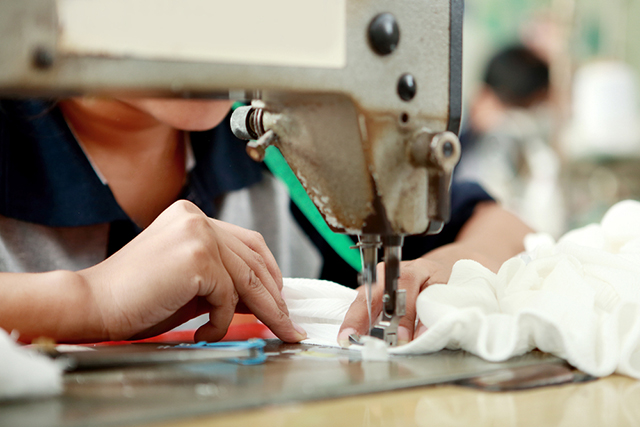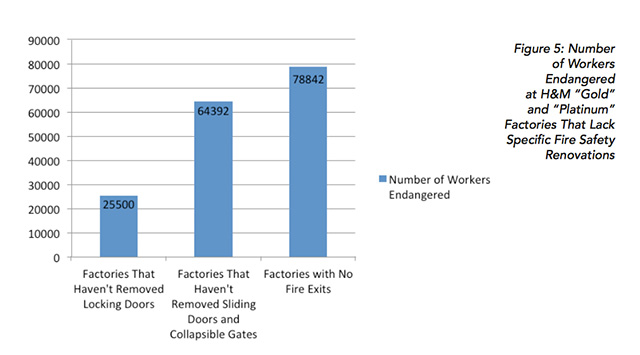
In September, Hennes & Mauritz AB (H&M) announced a new program to increase compensation for workers in 68 of its factories. H&M is the second-largest clothing retailer in Europe, with thousands of stores throughout the world. About 80 percent of its products come from Asian factories where workers receive poverty wages. H&M declared that it will bring a “fair wage method” to factories in Cambodia, China and Bangladesh, effectively raising salaries while also allowing for some union representation.
“If we can address the issue of wages and industrial relations, that will lead to more stable production markets,” Anna Gedda, H&M’s head of sustainability, told Bloomberg upon the announcement.
This isn’t the first time that H&M has vowed to improve its labor record. There has been increased pressure on the company to do so since 2013, when 1,129 people were killed in Bangladesh’s tragic Rana Plaza collapse. H&M is the single largest buyer of garments from the country. At the end of 2013, the company announced it had a “four-pronged approach” to raising wages. It would support factory owners and textile workers, improve purchasing practices and work with governments to assure that its labor practices were improved. H&M neglected to supply the public with much in the way of specifics and never actually revealed how much money it would begin paying its workers. However, that declaration contained the same phrase it’s currently using in regards to the matter: fair wage method.
“The fair wage method” was developed by Daniel Vaughan-Whitehead, a member of the United Nations’ International Labor Organization, who developed a methodology for improving supply-chain wage practices in 2006. The Fair Labor Association calls it a “measurement approach that looks at twelve dimensions of fair wages,” but it’s certainly not a concrete plan where actual numbers are involved. China Labor Watch’s Kevin Slaten told Truthout that H&M’s embrace of the method was merely a “quasi-plan” that remained “woefully unspecific” about whether workers would actually end up taking home more money.
In 2013, H&M also became the first brand to sign the Bangladesh Accord, a binding commitment to prevent future accidents in the Bangladeshi garment industry, which was created in response to the Rana Plaza disaster. At the time, H&M called on other companies to follow their lead. “We hope for a broad coalition of signatures in order for the agreement to work effectively,” said Helena Helmersson, H&M’s former head of sustainability, now its global head of production.
However, we now have a wealth of data that suggests that H&M hasn’t committed. According to a report recently published by the Clean Clothes Campaign, International Labor Rights Forum, Maquila Solidarity Network and Worker Rights Consortium, H&M has made very little progress in amending the problems with its Bangladesh supply factories. Not only is the company “dramatically behind schedule,” but the investigators only examined “platinum” and “gold” factories, which are supposed to be the ones with the highest labor standards.
 (Chart: Clean Clothes Campaign, International Labor Rights Forum, Maquila Solidarity Network, and Worker Rights Consortium)
(Chart: Clean Clothes Campaign, International Labor Rights Forum, Maquila Solidarity Network, and Worker Rights Consortium)
Sixty-one percent of the factories surveyed still lack fire exits. Sixteen percent of them still have doors that automatically lock, making exits virtually inaccessible in the case of a fire. While 16 percent might seem low, it’s important to think about the massive scope of the country’s garment industry: Sixteen percent means that 25,500 workers are endangered by locking doors. In 2010, a fire killed 50 people at a Bangladesh factory that supplied H&M with jumpers and cardigans. “Any factory where a lack of stairwell enclosure and fire doors has been identified, but where these hazards remain uncorrected, is effectively a death trap,” the report reads.
H&M released a statement in response to the study (which it dubbed a “Sustainability Update”). Their response acknowledges some delays but explains, “Although any delay is of great concern to us, it is of utmost importance that measures taken are according to the high quality standards agreed between the Bangladesh Government and the Accord/Alliance.” This is a confusing excuse considering the fact that H&M has been asked to account for the delays by the labor signatories of the accord and the accord’s own data shows that H&M has failed to make factories safe for workers. The accord does not actually provide brand-specific data, so it’s currently impossible to examine the particulars of H&M’s renovation financing, but the company’s sustainability reports informed customers that the most important factory modifications had already been made. H&M’s statement does not address this contradiction at all.
“H&M still has a lot of work to do at their supply factories in Bangladesh to ensure workers are safe.”
H&M’s failure to live up to its promises in Bangladesh has made it the recent target of actions and protests by United Students Against Sweatshops (USAS). “We have been organizing retail store actions across the country because we need consumers to know the truth about where H&M clothing comes from and to hold the company accountable to their promise to workers,” USAS international campaigns coordinator Morgan Currier told Truthout. “H&M still has a lot of work to do at their supply factories in Bangladesh to ensure workers are safe from fires, collapses and other deadly working conditions.”
Concerns about H&M’s labor practices certainly aren’t limited to Bangladesh. In 2012, a documentary aired on the Swedish television show “Kalla Fakta,” which revealed workers at H&M’s Cambodian factories were making as little as $61 per month while enduring horrendous labor conditions. H&M responded to the program with a vow to do better. “Our ambition is clearly set in our Code of Conduct,” its note read. “Everyone who works has the right to a just and favorable remunerations ensuring for himself and his family an existence worthy of human dignity.” Once again, specifics were absent from the company’s statement. Helena Helmersson, the previously mentioned former head of sustainability at H&M, told “Kalla Fakta” reporters, “We need to learn more about the conditions in different countries to see how bad the conditions are there.”
It’s hard to determine exactly what the company still needed to learn about considering the fact that Cambodia’s wage laws are public knowledge and regularly condemned by labor rights organizations. At the end of 2013, Cambodian garment workers went on strike demanding a minimum wage of $160 per month. $160 is still not a living wage in Cambodia, according to the Asia Floor Wage Alliance, which puts the number at $283 per month. Nonetheless, $160 was more than the government’s definitive $100 offer. A week into the strike the country’s military police fired into a crowd of protesting workers killing four of them. Recently, in response to worker unrest, the Cambodian government announced that it will raise the minimum wage of garment workers to $140 per month, but this is still extremely low by international standards.
In March 2015, Human Rights Watch released a 140-page report on the Cambodian garment industry, which relied on interviews with 270 workers from over 73 different factories. At one factory, which supplies for H&M, workers said that they had been forced to work on their days off to keep up with production targets and had received no overtime pay. Workers at that same factory claimed that children under the age of 15 were employed and were expected to work as vigorously as the adults. One of the interviewed workers estimated that there were about 20 children in her factory group. Another explained how her factory closely monitored worker production.
“They are now assessing how much time it takes to make a shirt,” she said. “I don’t know what H&M is thinking but this is very difficult for workers…. We can’t rest…. For some types of shirts they are setting 2,000 as quota. We have to meet this quota every day. Otherwise we get shouted at.” Sexual harassment is also a consistent aspect of the Cambodian garment industry, with managers commonly referring to workers by derogatory names if they fall behind factory expectations. “It’s terrible,” a worker told Human Rights Watch. “Women don’t really like it. We are never seen as equals. They target young and pretty girls. It’s just seen as normal. We can’t even keep track of the number of times they whistle or wink at us.”
These are just a few of the reasons that living wage advocates are skeptical about H&M’s new plan. Not only does it sound a lot like the company’s previous statements, but also it still lacks the specificity that some have been demanding from H&M for years. Yes, it claims that wages will rise in 68 factories, but it hasn’t even revealed which factories nor has it mentioned what the wages will be.
Scott Nova, executive director of the Worker Rights Consortium, told Truthout that this was simply more of the same. “Facing growing criticism, H&M has responded by claiming it is raising wages at some factories,” Nova said, “but H&M won’t disclose the names of the factories or the size of any increases and has only applied this nebulous policy to a miniscule percentage of its contract factories. This is what passes for progress in the world of ‘corporate social responsibility.'”
While H&M continues to make ambiguous announcements about improving their labor record, the way to actually do it is strikingly easy: They just have to raise wages. “H&M simply has to pay their supplier factories a higher rate so they can pay higher wages,” USAS’s Morgan Currier told Truthout. Nova told The Washington Post something very similar during the company’s first round of grandiose notifications in 2013: “If they want to pay living wages, they should pay living wages. They should give themselves a near-term deadline and give the world a number.”
The world does have a number when it comes to H&M’s chairman Stefan Persson: Forbes valued his net worth at about $24 billion in 2013.
Join us in defending the truth before it’s too late
The future of independent journalism is uncertain, and the consequences of losing it are too grave to ignore. To ensure Truthout remains safe, strong, and free, we need to raise $46,000 in the next 7 days. Every dollar raised goes directly toward the costs of producing news you can trust.
Please give what you can — because by supporting us with a tax-deductible donation, you’re not just preserving a source of news, you’re helping to safeguard what’s left of our democracy.